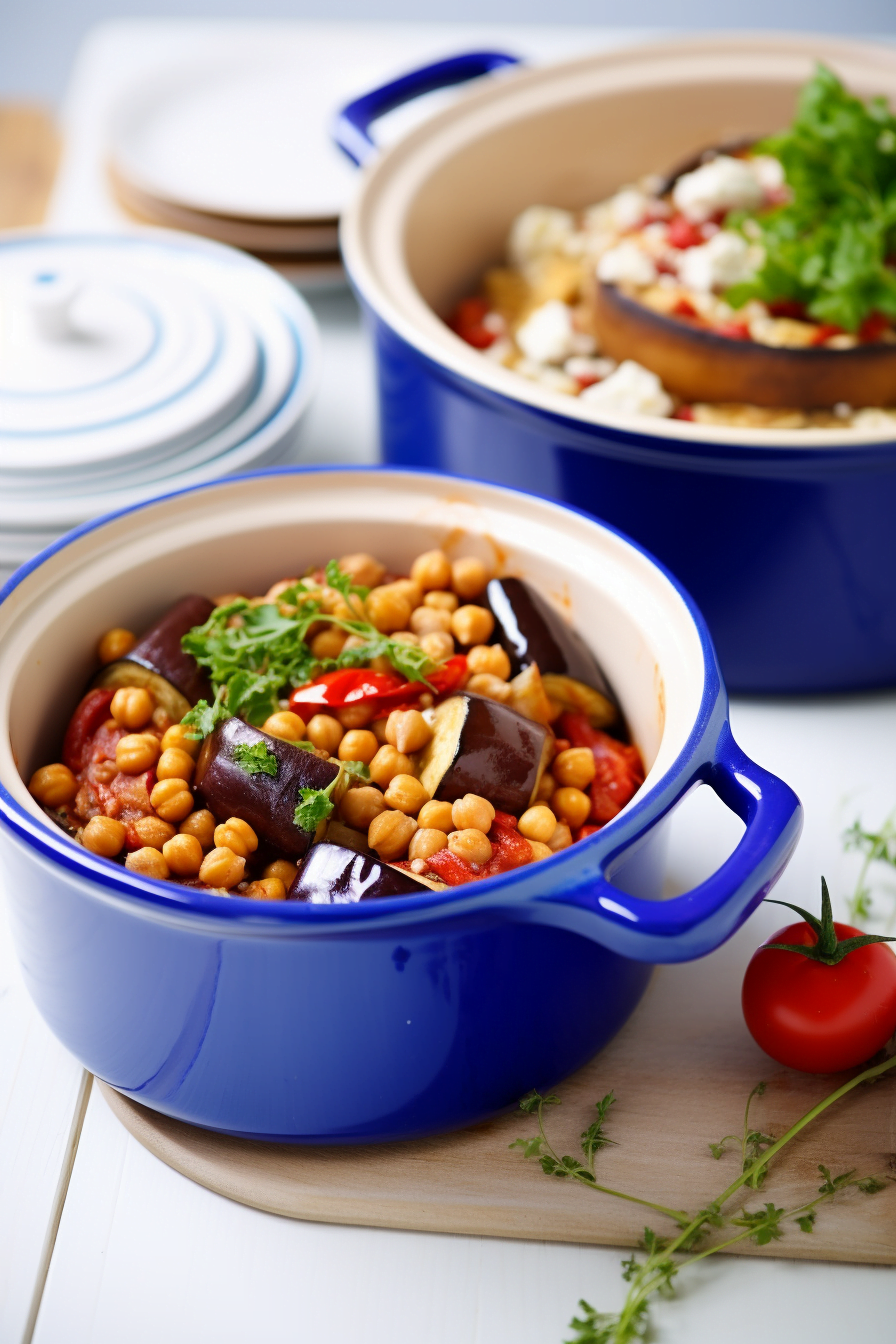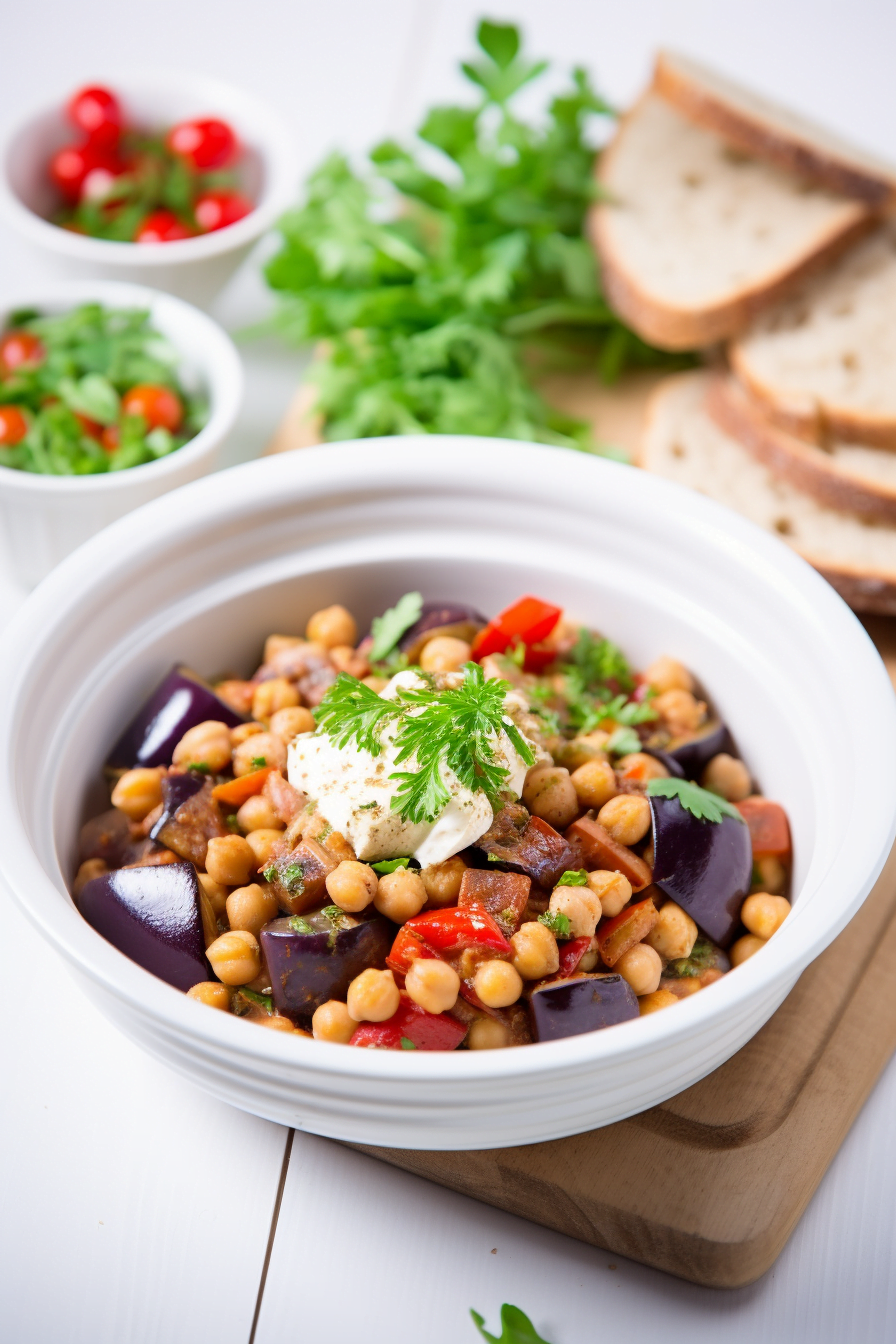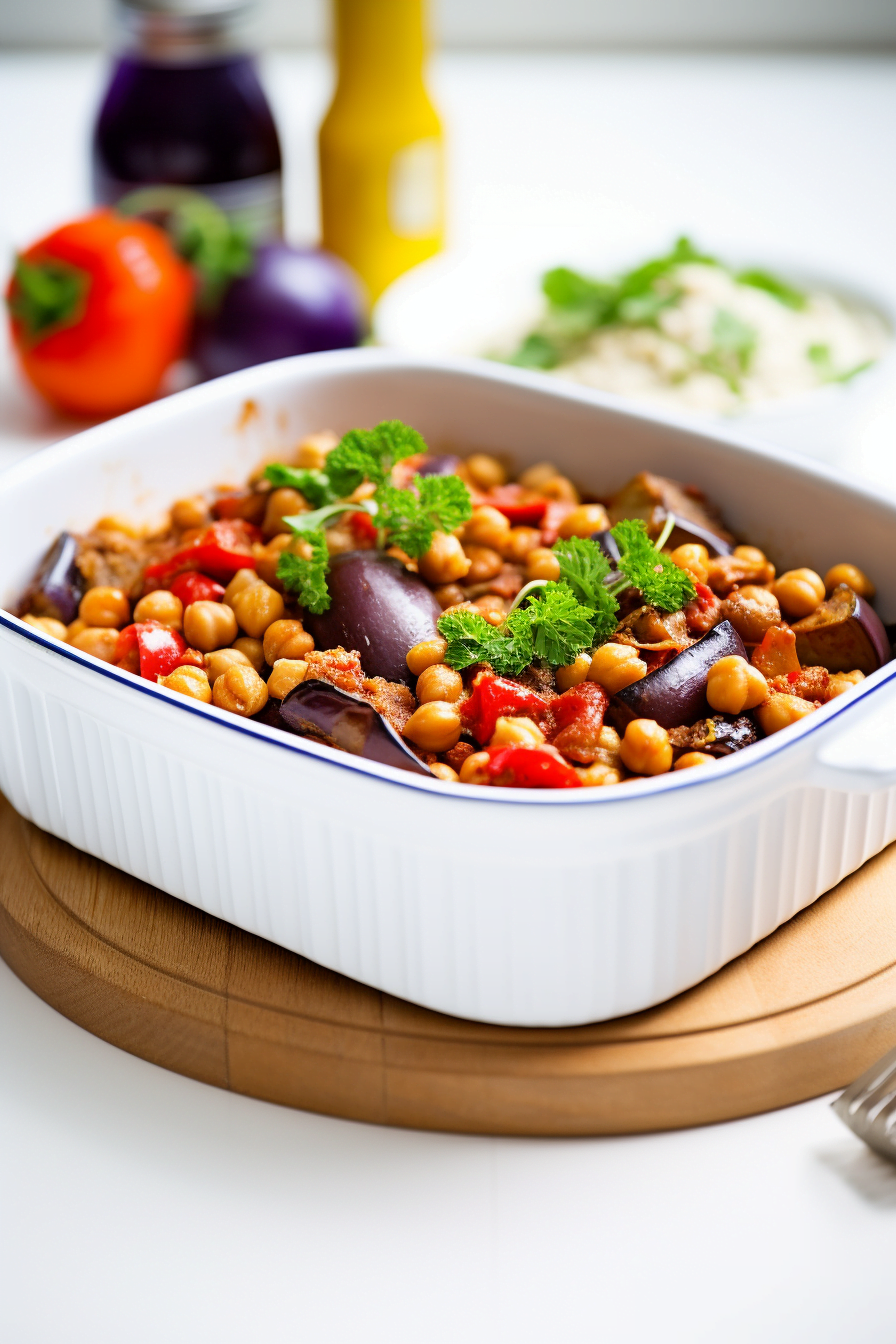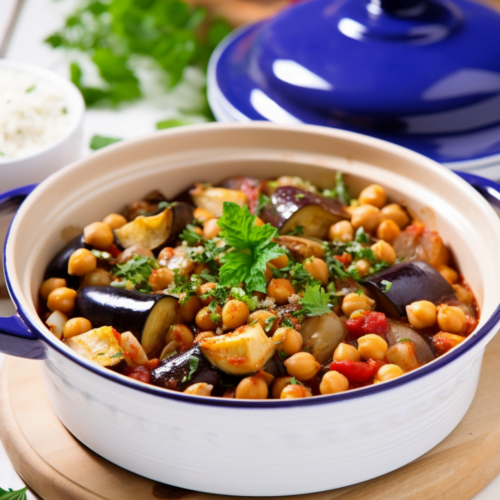Discover the Richness of Turkish Chickpea and Eggplant Stew (Nohutlu Patlıcan)
Welcome to a culinary journey that will transport your senses to the heart of Turkey with our **Turkish Chickpea and Eggplant Stew (Nohutlu Patlıcan)**. This stew, a staple in Turkish households, is not just a meal; it’s a celebration of flavors, nutrition, and tradition. Perfect for those seeking a hearty and healthy dish, this recipe promises to be a comforting addition to your dinner table. As you follow along, you’ll uncover the secrets to creating this authentic Mediterranean delight that’s both satisfying and nourishing.
Whether you’re a seasoned cook or a novice in the kitchen, this guide will walk you through the process of crafting a stew that’s brimming with the essence of Turkish cuisine. Get ready to immerse yourself in a world of aromatic spices and fresh ingredients that come together to form a dish that’s truly greater than the sum of its parts.

The Story Behind Nohutlu Patlıcan
The origins of **Nohutlu Patlıcan** trace back to the diverse culinary landscape of Turkey, where eggplants are more than just a vegetable; they are a symbol of cultural heritage. This dish, with its humble beginnings, has traversed through time and regions, from the bustling streets of Istanbul to the serene landscapes of Anatolia, each adding its own touch to the recipe.
In Turkey, the combination of chickpeas and eggplants is a testament to the country’s love for legumes and vegetables, which are central to its diet. The dish’s inspiration comes from the need for nourishing, plant-based meals that could be easily prepared with locally sourced ingredients. It’s a reflection of the Mediterranean diet’s emphasis on healthful eating, with a focus on vegetables, whole grains, and the liberal use of olive oil.
**Turkish Chickpea and Eggplant Stew** is a versatile dish, often enjoyed during the colder months for its warming properties. However, its lightness and nutritional value make it a year-round favorite. The spices used, such as cumin, paprika, and cinnamon, are staples in Turkish pantries, providing depth and complexity to the stew. The addition of lemon and parsley as garnishes is a nod to the Turkish tradition of using fresh herbs to elevate the flavors of a dish.
As you embark on making this stew, you’re not just cooking a meal; you’re weaving a tapestry of flavors that have been cherished for generations. The **Nohutlu Patlıcan** is more than food; it’s a narrative of Turkish hospitality, comfort, and the simple joy of sharing a meal with loved ones.

Mastering the Method
Creating the perfect **Turkish Chickpea and Eggplant Stew** is an art that involves more than just following a recipe; it’s about understanding the nuances of each ingredient and technique. Let’s dive into the details that will elevate your stew from good to exceptional.
**Prepping the Eggplant**: Eggplants are notorious for their bitterness, which can be mitigated by salting the cubes before cooking. This step, known as “degorging,” draws out moisture and bitterness, resulting in a more concentrated flavor. After salting, be sure to rinse the eggplant thoroughly to remove excess salt and pat them dry. This ensures that your eggplants will be ready to absorb the rich flavors of the stew.
**Sautéing for Success**: The base of any great stew is the sautéing of onions and garlic. This foundational step is crucial as it builds the flavor profile. Cook them until they are just translucent to avoid burning, which can impart a bitter taste. When you add the spices, stir them constantly to prevent scorching. This brief cooking releases their essential oils, which is key to achieving the stew’s signature aroma and taste.
**Simmering with Patience**: Once all the ingredients are in the pot, the magic happens during the simmering stage. This slow cooking process allows the flavors to meld and the eggplant to become tender. Keep the stew covered and resist the urge to stir too often, as this can break down the vegetables too much. A gentle, occasional stir is all that’s needed. The result should be a harmonious blend of flavors where each ingredient shines while contributing to the overall taste.
Remember, the stew’s consistency should be thick and hearty, but if you find it too dense, feel free to add a little more broth to reach your desired texture. On the other hand, if it’s too thin, let it simmer uncovered for a few minutes to reduce and concentrate the flavors.

Variations to Nohutlu Patlıcan
Adding Protein
For those looking to add a protein punch to their **Nohutlu Patlıcan**, consider incorporating cubes of lamb or beef. The rich meats complement the earthiness of the chickpeas and eggplants, while adding a savory depth to the stew. Brown the meat before adding the onions and garlic to ensure a flavorful sear that locks in juices.
Spicy Twist
If you enjoy a bit of heat, introduce some Turkish chili flakes, known as pul biber, to the spice mix. This will not only add a spicy kick but also a subtle smokiness that pairs beautifully with the sweetness of the vegetables.
Seasonal Vegetables
Embrace the seasons by adding or substituting ingredients based on what’s fresh and available. Zucchini, bell peppers, or root vegetables like carrots and potatoes can make excellent additions, adding variety in texture and flavor to the stew.
Ingredient Substitutions
For Eggplants
If eggplants are not your favorite or simply not available, zucchini can be a suitable substitute. They have a similar ability to absorb flavors and provide a comparable texture when cooked down in the stew.
Chickpea Alternatives
Chickpeas are central to this dish, but white beans or lentils can offer a different take while still maintaining the heartiness of the stew. Adjust cooking times accordingly, as different legumes have varying cooking requirements.
Tomato Paste Swap
If tomato paste is not on hand, a good quality tomato sauce can be used in its place. The sauce may be thinner, so you might need to reduce the broth slightly to achieve the right consistency for your stew.
Frequently Asked Questions
Can I make this stew in a slow cooker?
Yes, **Nohutlu Patlıcan** can be adapted for a slow cooker. Simply sauté the onions, garlic, and spices as directed, then transfer to the slow cooker with the remaining ingredients and cook on low for 6-8 hours.
How can I prevent the eggplants from becoming too mushy?
To keep eggplants from overcooking, add them later in the cooking process and ensure they are cubed in larger pieces. Monitor the stew closely as it simmers.
Is this stew gluten-free?
Yes, as long as the vegetable broth used is certified gluten-free, this stew is naturally gluten-free.
Can I freeze this stew?
This stew freezes well. Cool it completely before freezing in an airtight container. Thaw in the refrigerator overnight and reheat gently on the stove.
What can I serve with this stew?
Traditionally, it’s served with rice, bulgur, or crusty bread. For a lighter option, pair it with a simple green salad.

Turkish Chickpea and Eggplant Stew (Nohutlu Patlıcan)
Equipment
- Large pot or Dutch oven
- Knife
- Cutting board
- Measuring cups and spoons
- Paper towels
Ingredients
- 2 medium eggplants (aubergines), cubed (approx. 1 lb / 450 g)
- 1 can chickpeas (15 oz / 425 g), drained and rinsed
- 1 large onion, finely chopped (approx. 8 oz / 225 g)
- 3 cloves garlic, minced
- 1 red bell pepper, diced (approx. 5 oz / 140 g)
- 2 medium tomatoes, diced (approx. 1 lb / 450 g)
- 3 tbsp olive oil (45 ml)
- 2 tsp ground cumin (4 g)
- 1 tsp smoked paprika (2 g)
- 1/2 tsp ground cinnamon (1 g)
- 1/4 tsp cayenne pepper (0.5 g), optional for heat
- 2 cups vegetable broth (480 ml)
- 1 tbsp tomato paste (15 g)
- Salt and freshly ground black pepper, to taste
- Fresh parsley, chopped for garnish
- 1 lemon, cut into wedges for serving
Instructions
- Prep the Eggplant: Begin by salting the cubed eggplant and letting it sit for about 10 minutes. This helps to remove any bitterness. Rinse the eggplant under cold water and pat dry with paper towels.
- Sauté the Vegetables: In a large pot or Dutch oven, heat the olive oil over medium heat. Add the chopped onion and garlic, cooking until the onion is translucent, about 3-4 minutes.
- Add Spices: Stir in the ground cumin, smoked paprika, ground cinnamon, and cayenne pepper, and cook for an additional minute until the spices are fragrant.
- Cook Eggplant: Add the eggplant cubes to the pot and sauté for about 5 minutes, or until they start to soften.
- Combine Ingredients: To the pot, add the diced red bell pepper, tomatoes, chickpeas, vegetable broth, and tomato paste. Season with salt and pepper to taste.
- Simmer Stew: Bring the stew to a boil, then reduce the heat to low and simmer, covered, for 30-35 minutes, stirring occasionally, until the vegetables are tender and the flavors have melded together.
- Garnish and Serve: Once the stew is done, check for seasoning and adjust if necessary. Serve hot, garnished with fresh parsley and lemon wedges on the side.
Notes

